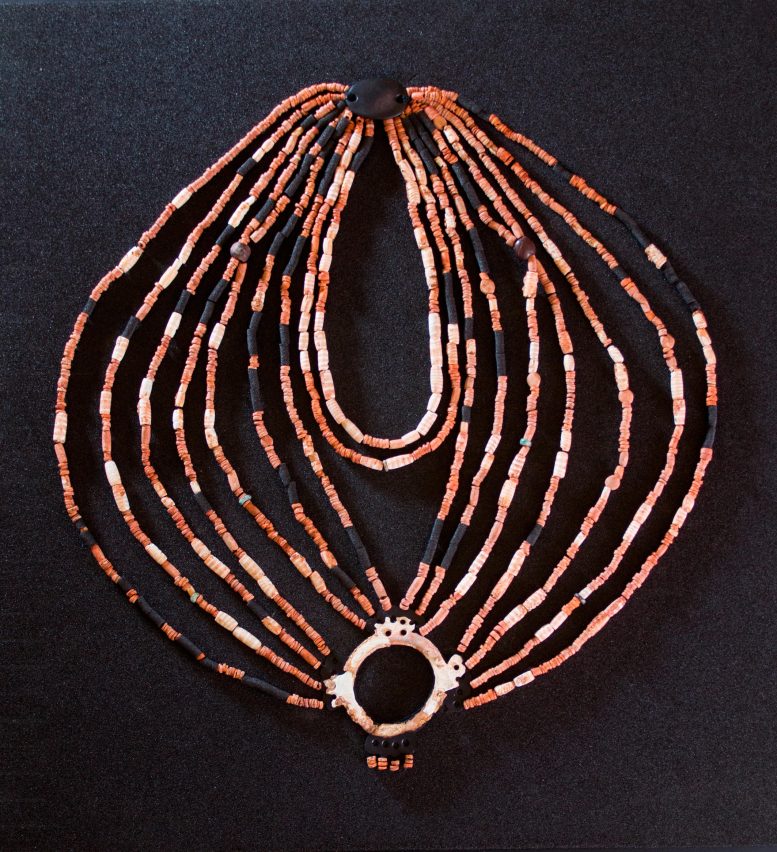
An ancient necklace from a child’s grave in Jordan reveals the Neolithic culture’s social intricacies, highlighting the importance of adornments and suggesting complex societal dynamics of the period. Final physical reconstruction of the necklace, today exposed at the new museum of Petra in Jordan. Credit: Alarashi et al., 2023, PLOS ONE, CC-BY 4.0
Analysis of the body ornament from Jordan identifies a complex interplay of art, trade, status, and funerary practice.
A single accessory, an ornate necklace found in a child’s grave in ancient Jordan, sheds new light on the social complexity of Neolithic culture. This finding was detailed in a study recently published in the journal PLOS ONE by Hala Alarashi of the Consejo Superior de Investigaciones Científicas, Spain, and the Université Côte d’Azur, France, along with other colleagues.
Significance of Body Adornments
Body adornments are powerful symbols that communicate cultural values and personal identities, and they are therefore highly valuable in the study of ancient cultures. In this study, Alarashi and colleagues analyze materials that adorned the body of an eight-year-old child buried in a grave at the Neolithic village of Ba’ja in Jordan, dating to between 7400 and 6800 BCE.
Details of the Discovery
The materials in question comprise over 2,500 colorful stones and shells, two exceptional amber beads – the oldest known thus far in the Levant – along with a large stone pendant and a delicately engraved mother-of-pearl ring. Analyzing the composition, craftsmanship, and spatial layout of these items, the authors conclude that they belonged to a single composite multi-row necklace that had since fallen apart. As part of this study, the researchers created a physical reconstruction of the original necklace, which is now on display in the Petra Museum in Southern Jordan.
Insights and Implications
The multi-row necklace is one of the oldest and most impressive Neolithic ornaments, providing new insights into funerary practices at the time for individuals of apparently high social status. The making of the necklace appears to have involved meticulous work, as well as the import of certain exotic materials from other regions. The study of this necklace reveals complex social dynamics between community members at Ba’ja – including artisans, traders, and high-status authorities who would commission such pieces – which certainly merit further investigation of this Neolithic culture.
The authors add: “Adorning the deceased child, bridging the worlds of life and death: The discovery and reconstruction of an extraordinary necklace from the 9000-year-old village of Ba’ja (Jordan).”
Reference: “Threads of memory: Reviving the ornament of a dead child at the Neolithic village of Ba`ja (Jordan)” by Hala Alarashi, Marion Benz, Julia Gresky, Alice Burkhardt, Andrea Fischer, Lionel Gourichon, Melissa Gerlitzki, Martin Manfred, Jorune Sakalauskaite, Beatrice Demarchi, Meaghan Mackie, Matthew Collins, Carlos P. Odriozola, José Ángel Garrido Cordero, Miguel Ángel Avilés, Luisa Vigorelli, Alessandro Re and Hans Georg K. Gebel, 2 August 2023, PLOS ONE.
DOI: 10.1371/journal.pone.0288075









Looking at this, I stared at it, looking for patterns. I was thinking of the Inca string and knot information coding system. Imagine the stories that the necklace could be coding. Maybe that was their real function all along, not decoration alone. It could be that when we make jewelry like that today, we are aping an ancient tech we do not understand, like the island natives who make fake airplane things.